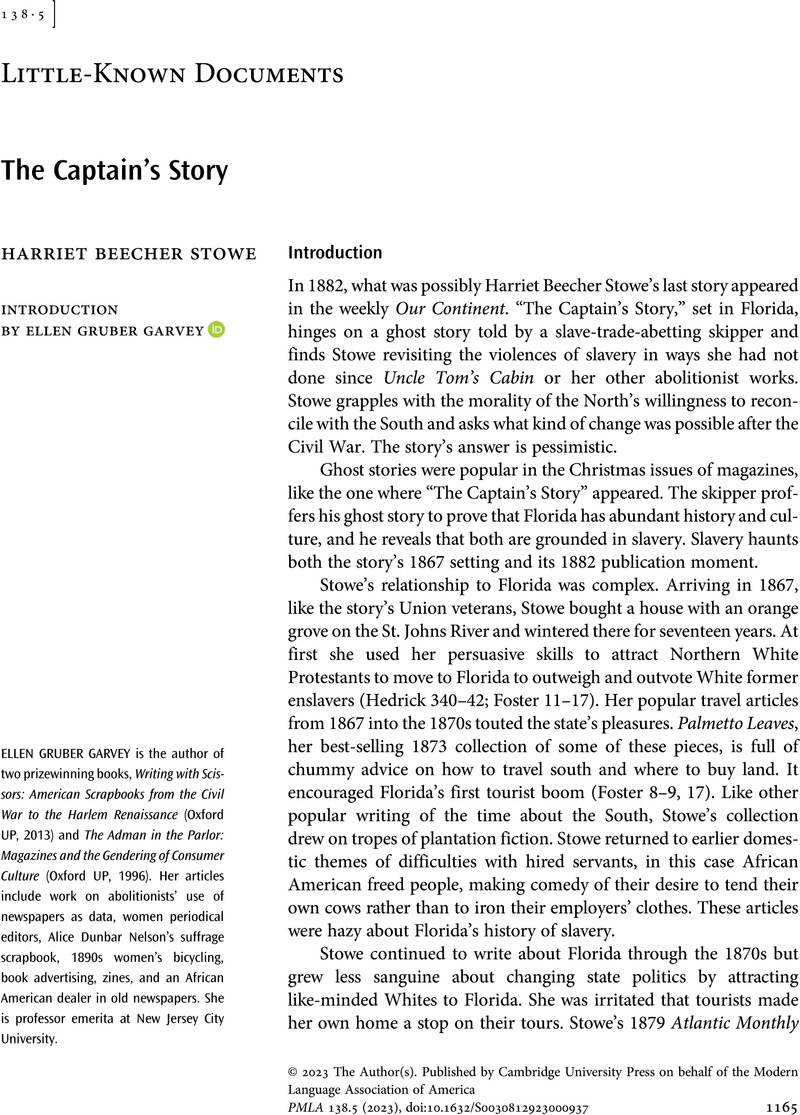No CrossRef data available.
Article contents
The Captain's Story
Published online by Cambridge University Press: 02 January 2024
Abstract
An abstract is not available for this content so a preview has been provided. Please use the Get access link above for information on how to access this content.

Information
- Type
- Little-Known Documents
- Information
- Copyright
- Copyright © 2023 The Author(s). Published by Cambridge University Press on behalf of the Modern Language Association of America
References
Works Cited
Blight, David. Race and Reunion: The Civil War in American Memory. Harvard UP, 2001.10.4159/9780674022096CrossRefGoogle Scholar
Dickinson, Anna E. “A Lady Orator's Views.” New York Press, vol. 1, no. 200, 17 June 1888. “Anna E. Dickinson Papers: Miscellany, 1863–1951; Scrapbooks; Circa 1888–1895,” Library of Congress, www.loc.gov/resource/mss18424.mss18424-024_0563_0640/?sp=9&st=image&r=0.244,-0.005,0.647,0.303,0.Google Scholar
Elliott, Mark. Color-Blind Justice: Albion Tourgée and the Quest for Racial Equality from the Civil War to Plessy v. Ferguson. Oxford UP, 2008.Google Scholar
Foster, John T. “Correcting History: An Introduction.” Calling Yankees to Florida: Harriet Beecher Stowe's Forgotten Tourist Articles, edited by Foster, Sarah Whitmer Foster, , 2nd ed., Florida Historical Society Press, 2019, pp. 5–32.Google Scholar
Garvey, Ellen Gruber. “A Forgotten Nineteenth-Century Story Can Help Us Navigate Today's Political Fractures.” The Washington Post, 23 Mar. 2021, www.washingtonpost.com/outlook/2021/03/23/forgotten-19th-century-story-can-help-us-navigate-todays-political-fractures/.Google Scholar
Hedrick, Joan D. Harriet Beecher Stowe: A Life. Oxford UP, 1995.10.1093/acprof:oso/9780195096392.001.0001CrossRefGoogle Scholar
“Independent Journalism.” Our Continent, 15 Mar. 1882, p. 72.Google Scholar
Silber, Nina. The Romance of Reunion: Northerners and the South, 1865–1900. U of North Carolina P, 1993.Google Scholar
Stowe, Harriet Beecher. “The Captain's Story.” Our Continent, 27 Dec. 1882, pp. 790–93.10.1093/oso/9780195166958.003.0005CrossRefGoogle Scholar
Stowe, Harriet Beecher. Introduction. The Florida Annual: Impartial and Unsectional, 1884, edited by Munroe, C. K., Vaux, 1883, pp. 5–6.Google Scholar
Stowe, Harriet Beecher. “Our Florida Plantation.” The Atlantic Monthly, May 1879, pp. 641–49.Google Scholar

